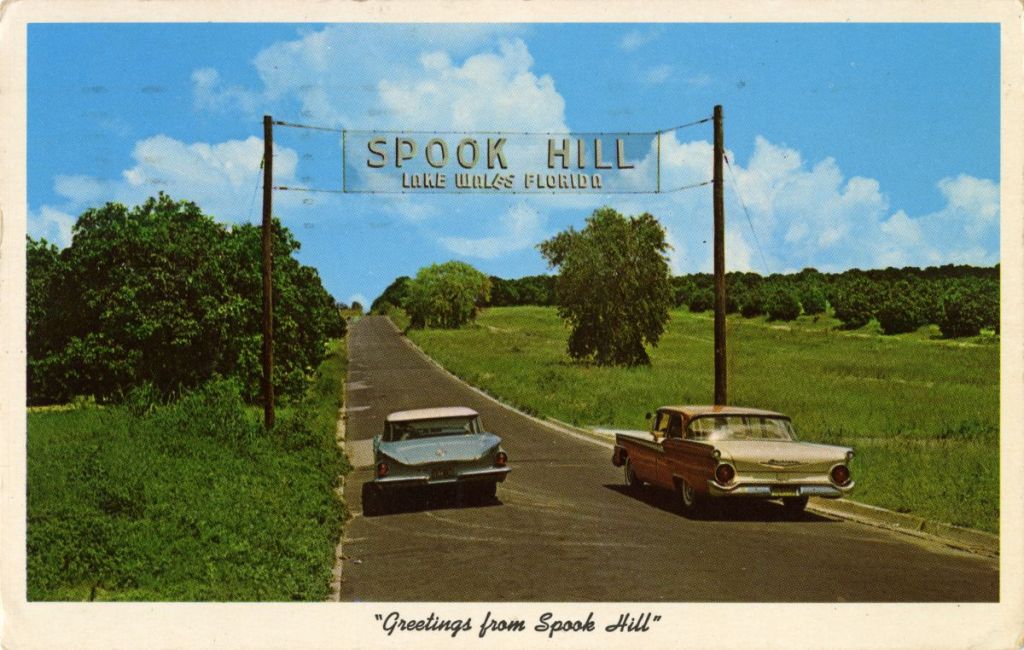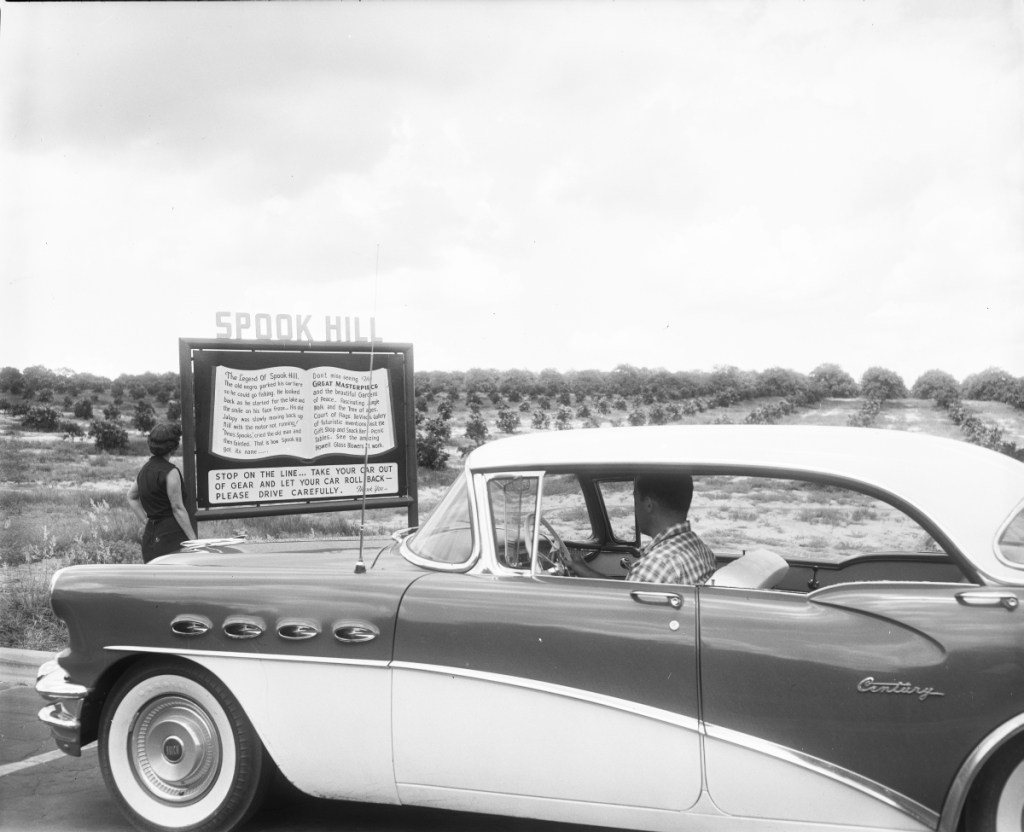Spook Hill became a tourist attraction in the 1950s when Barney’s Restaurant in Lake Wales, Florida published a leaflet describing the “facts” associated with the gravity hill. A gravity hill is an optical illusion whereby someone places a car in neutral on an undetectable downhill slope and the vehicle rolls uphill. In reality, the vehicle is rolling downhill, but the occupants don’t realize this because they do not have a true horizon line to focus on. Instead, they feel like they are being pulled uphill. Gravity hills are also called magnetic hills, for some believe there is a magnetic pull causing the vehicle to move. Spook Hill is the only documented gravity hill in Florida, and early marketing agents quickly seized upon it.
Back in the 1800s, men rode horses to deliver mail along postal mail roads. These roads were well used and ran across the nation. Florida was no exception. However, the horses were spooked along the road running along this hill. The horses would pull and tug when crossing this portion of the trail. Hence, the name Spook Hill was christened.
This strange phenomenon was marketed as having three folktales attached.
The first legend claims that a 16th century pirate, Captain Gimme Sarsaparilla, retired from his life of plundering on the high seas to live as a “gentleman” in the Lake Wales area in 1511. He sought the retired life of a whaling fisherman. (Honest. This was actually printed. Hint: There aren’t any whales in the interior of Florida.) Joining Captain Gimme was his aid Teniente Vincento Alfredo Nieto Isidoro Lima Llano Alvarez. Vanilla for short. (A few versions have Captain Gimme being a distant cousin to Jose Gaspar, also known as Gasparilla; however, this is not possible for at least 2 reasons: there are 200 years between their lives, which makes them distant, distant—really distant—cousins and also because there is not any evidence that any of these people actually existed.)
The story continues that Teniente died and was buried at the foot of a hill. Gimme’s remains are at the bottom on North Lake Wales, the smaller lake in the town close to Spook Hill. When automobile travel became affordable, in the 1950s, an urban legend was formed. Claiming that a car parked at the foot of the hill totaled 16 men in weight, Teniente’s skeletal chest was being crushed by the weight. His spirit called to Gimme whose spirit pushed the car uphill. Some Internet stories (and the Barney’s leaflet) claim the basis for this as “16 Men on a Dead Man’s Chest.” This, of course, is mistaken. The phrase is “15 Men on a Dead Man’s Chest,” a fictional pirate sea song created by Robert Louis Stevenson in Treasure Island. Note that Treasure Island was written in 1883, much later than Captain Gimme’s lifetime.
The second story involves a Native American tribe located in central Florida. This may have involved a few tribes; therefore, it is difficult to identify which tribe this could be, although the Barney’s leaflet stated it was the Seminole tribe. Chief Culcowellax battled a mighty alligator that was terrorizing the reservation. One or both did not survive the event, with one or both supposedly pulling a vehicle backwards. Supposedly, the chieftain was buried on the north side of the hill. (Note: There are not any records online for Chief Culcowellax.)
The third version involves an unsuspecting Black man who parked his “jalopy” at the foot of the hill to go fishing prior to 1956. Instead of placing the car in “park,” he put it in “neutral” and watched as his car went up the hill 75-100 feet. He exclaimed: “Them’s spooks” or “Dem’s spooks” or simply “Spooks.” He fainted afterwards. (There are so many issues with this version starting with the use of the word “jalopy.” It’s an insult for an old, beat-up car. Language warning on additional words used if looking at old images of this story.)
Lake Wales was surveyed in 1879 by Sidney Irving Wailes, who renamed the larger lake after himself. Later, four businessmen changed the spelling to Wales and began development.
Spook Hill Elementary School opened in the fall of 1956. Two years later, the school adopted Casper, the Friendly Ghost, as the official mascot. Alfred Harvey, president of Harvey Comics, was happy to grant permission for the use.
The strangest story published about Spook Hill comes from a 1958 newspaper article. In a spin on Groundhog Day, the story states that if a car in neutral travels farther uphill on Halloween night, then the axle grease is warm, signaling that the winter months will be warmer than normal.
Much of the lore regarding Spook Hill was created by Barney’s Tavern. They collectively attempted to rewrite the history of the area to drum up business. Two slogans used were “famous for food” and “where fastidious people get superior service at moderate cost.” Established in 1936, the restaurant sold postcards and printed a menu that could be folded to mail. In a pre-theme park era, Barney’s capitalized on the uniqueness of the scenic highlands of Florida where tourists could experience strange phenomena and observe wildlife.


While Spook Hill is an explainable gravity hill optical illusion, it is still a thrilling sensation. On April 5, 2019, it was placed on the National Register of Historic Places, showing that locations, even those without buildings, are significant to the American experience. Even if the experience is a trick of the mind.

























You must be logged in to post a comment.